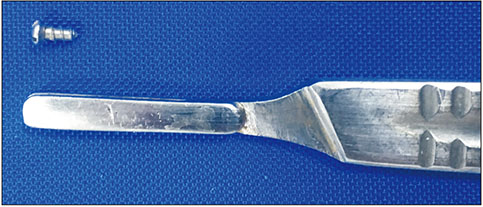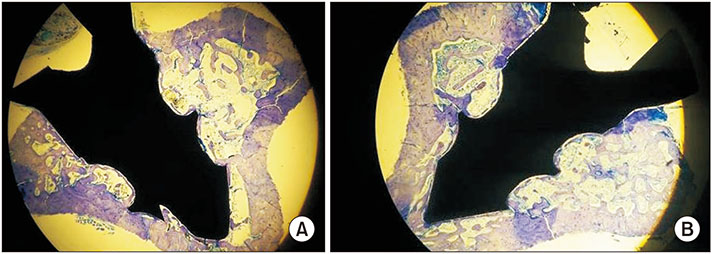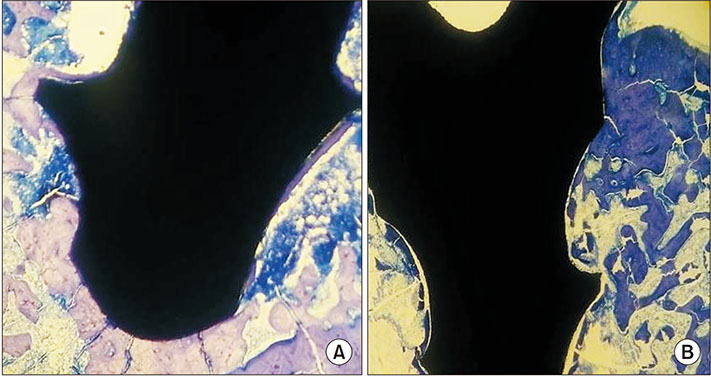J Korean Assoc Oral Maxillofac Surg.
2019 Apr;45(2):91-96. 10.5125/jkaoms.2019.45.2.91.
An experimental investigation of the effects of chronic stress on bone-to-implant contact
- Affiliations
-
- 1Department of Periodontology, Faculty of Dentistry, Firat University, Elazig, Turkey. dtserkandundar@gmail.com
- 2Private Practice, Oral and Maxillofacial Surgeon, Diyarbakir, Turkey.
- 3Private Practice, Oral and Maxillofacial Surgeon, Toronto, Canada.
- 4Department of Physiology, Faculty of Medicine, Firat University, Elazig, Turkey.
- 5Department of Periodontology, Faculty of Dentistry, Yüzüncü Yıl University, Van, Turkey.
- 6Department of Mechanical Engineering, Faculty of Engineering, Firat University, Elazig, Turkey.
- KMID: 2467152
- DOI: http://doi.org/10.5125/jkaoms.2019.45.2.91
Abstract
OBJECTIVES
This study aimed to investigate the effects of chronic restraint stress on the osseointegration of titanium implants.
MATERIALS AND METHODS
Twenty adult male Wistar albino rats were used in the study. After surgical insertion of titanium implants into the metaphyseal part of the tibial bone, rats were randomly divided into two groups: a control group (CNT group) and an experimental restraint stress group (RS group). In the CNT group, titanium implants were inserted surgically, and rats received no further treatment during the 47-day experimental period. In the RS group, restraint stress was applied for 3 hours per day for 45 days, beginning 2 days after implant surgery. Weight of the rats was measured prior to surgery and at the end of the study to analyze the effects of stress. At the end of the experimental period, rats were euthanized, and implants and surrounding bone tissues were used for undecalcified histological analysis. Serum cortisol levels were assessed in cardiac blood samples from the rats following centrifugation.
RESULTS
Average weight of rats in the RS group was lower than that of rats in the CNT group after the experimental protocol had been completed (P<0.05). Further, serum cortisol levels were higher in the RS group than in the CNT group (P<0.05). There were no significant differences in bone-implant connection levels between the two groups (P>0.05).
CONCLUSION
The data analyzed in this study suggest that chronic restraint stress did not adversely affect rats during a 45-day osseointegration period.
Keyword
MeSH Terms
Figure
Reference
-
1. Sapolsky RM. Stress, glucocorticoids, and damage to the nervous system: the current state of confusion. Stress. 1996; 1:1–19.
Article2. Takada T, Yoshinari N, Sugiishi S, Kawase H, Yamane T, Noguchi T. Effect of restraint stress on the progression of experimental periodontitis in rats. J Periodontol. 2004; 75:306–315.
Article3. Dyb G, Jensen TK, Nygaard E, Ekeberg O, Diseth TH, Wentzel-Larsen T, et al. Post-traumatic stress reactions in survivors of the 2011 massacre on Utøya Island, Norway. Br J Psychiatry. 2014; 204:361–367.
Article4. Semenoff-Segundo A, Porto AN, Semenoff TA, Cortelli JR, Costa FO, Cortelli SC, et al. Effects of two chronic stress models on ligature-induced periodontitis in Wistar rats. Arch Oral Biol. 2012; 57:66–72.
Article5. Rozanski A, Blumenthal JA, Davidson KW, Saab PG, Kubzansky L. The epidemiology, pathophysiology, and management of psychosocial risk factors in cardiac practice: the emerging field of behavioral cardiology. J Am Coll Cardiol. 2005; 45:637–651.
Article6. Dantzer R, Kelley KW. Stress and immunity: an integrated view of relationships between the brain and the immune system. Life Sci. 1989; 44:1995–2008.
Article7. Nakajima K, Hamada N, Takahashi Y, Sasaguri K, Tsukinoki K, Umemoto T, et al. Restraint stress enhances alveolar bone loss in an experimental rat model. J Periodontal Res. 2006; 41:527–534.
Article8. Marucha PT, Kiecolt-Glaser JK, Favagehi M. Mucosal wound healing is impaired by examination stress. Psychosom Med. 1998; 60:362–365.
Article9. Padgett DA, Marucha PT, Sheridan JF. Restraint stress slows cutaneous wound healing in mice. Brain Behav Immun. 1998; 12:64–73.
Article10. Carvas JS, Pereira RM, Caparbo VF, Fuller P, Silveira CA, Lima LA, et al. A single dose of zoledronic acid reverses the deleterious effects ofglucocorticoids on titanium implant osseointegration. Osteoporos Int. 2010; 21:1723–1729.
Article11. Frisch E, Ziebolz D, Rinke S. Long-term results of implant-supported over-dentures retained by double crowns: a practice-based retrospective study after minimally 10 years follow-up. Clin Oral Implants Res. 2013; 24:1281–1287.
Article12. Dundar S, Yaman F, Saybak A, Ozupek MF, Toy VE, Gul M, et al. Evaluation of effects of topical melatonin application on osseointegration of dental implant: an experimental study. J Oral Implantol. 2016; 42:386–389.
Article13. Correa MG, Gomes Campos ML, César-Neto JB, Casati MZ, Nociti FH, Sallum EA. Histometric evaluation of bone around titanium implants with different surface treatments in rats exposed to cigarette smoke inhalation. Clin Oral Implants Res. 2009; 20:588–593.
Article14. Siqueira CR, Semenoff TA, Palma VC, Borges ÁH, Silva NF, Segundo AS. Effect of chronic stress on implant osseointegration into rat's mandible. Acta Cir Bras. 2015; 30:598–603.
Article15. Conte Neto N, de Andrade CR, Spolidorio LC, Planeta Cda S, Cruz FC, de Souza Bastos A, et al. Effects of chronic stress and alendronate therapy on the osseointegration of titanium implants. Clin Implant Dent Relat Res. 2014; 16:762–771.
Article16. Dündar S, Yaman F, Ozupek MF, Saybak A, Gul M, Asutay F, et al. The effects of high-fat diet on implant osseointegration: an experimental study. J Korean Assoc Oral Maxillofac Surg. 2016; 42:187–192.
Article17. Dundar S, Yaman F, Gecor O, Cakmak O, Kirtay M, Yildirim TT, et al. Effects of local and systemic zoledronic acid application on titanium implant osseointegration: an experimental study conducted on two surface types. J Craniofac Surg. 2017; 28:935–938.
Article18. Park MH, Rehman SU, Kim IS, Choi MS, Yoo HH. Stress-induced changes of neurosteroid profiles in rat brain and plasma under immobilized condition. J Pharm Biomed Anal. 2017; 138:92–99.
Article19. Hasturk H, Kantarci A. Activation and resolution of periodontal inflammation and its systemic impact. Periodontol 2000. 2015; 69:255–273.
Article20. Kantarci A, Hasturk H, Van Dyke TE. Animal models for periodontal regeneration and peri-implant responses. Periodontol 2000. 2015; 68:66–82.
Article21. Chiu CT, Chiang WF, Chuang CY, Chang SW. Resolution of oral bisphosphonate and steroid-related osteonecrosis of the jaw--a serial case analysis. J Oral Maxillofac Surg. 2010; 68:1055–1063.
Article22. Yamamoto T, Hirano K, Tsutsui H, Sugioka Y, Sueishi K. Corticosteroid enhances the experimental induction of osteonecrosis in rabbits with Shwartzman reaction. Clin Orthop Relat Res. 1995; (316):235–243.
Article23. Weinstein RS. Glucocorticoids, osteocytes, and skeletal fragility: the role of bone vascularity. Bone. 2010; 46:564–570.
Article24. Romana-Souza B, Otranto M, Vieira AM, Filgueiras CC, Fierro IM, Monte-Alto-Costa A. Rotational stress-induced increase in epinephrine levels delays cutaneous wound healing in mice. Brain Behav Immun. 2010; 24:427–437.
Article25. Mahgoub A, Hirsch PF, Munson PL. Calcium-lowering action of glucocorticoids in adrenalectomized-parathyroidectomized rats. Specificity and relative potency of natural and synthetic glucocorticoids. Endocrine. 1997; 6:279–283.
Article
- Full Text Links
- Actions
-
Cited
- CITED
-
- Close
- Share
- Similar articles
-
- THREE DIMENSIONAL FINITE ELEMENT ANALYSIS ON THE MINMUM CONTACT FRACTION OF BONE-IMPLANT INTERFACE
- An evaluation of angles between the alveolar crest bone and the implant effect on the implant crestal area induced stresses using a finite element method
- A study on the finite element analysis and bone formation of the apically expandable implant
- Three-dimensional finite element analysis for stress distribution on the diameter of orthodontic mini-implants and insertion angle to the bone surface
- Photoelastic stress analysis of load transfer to satellite abutment as an immediate abutment




